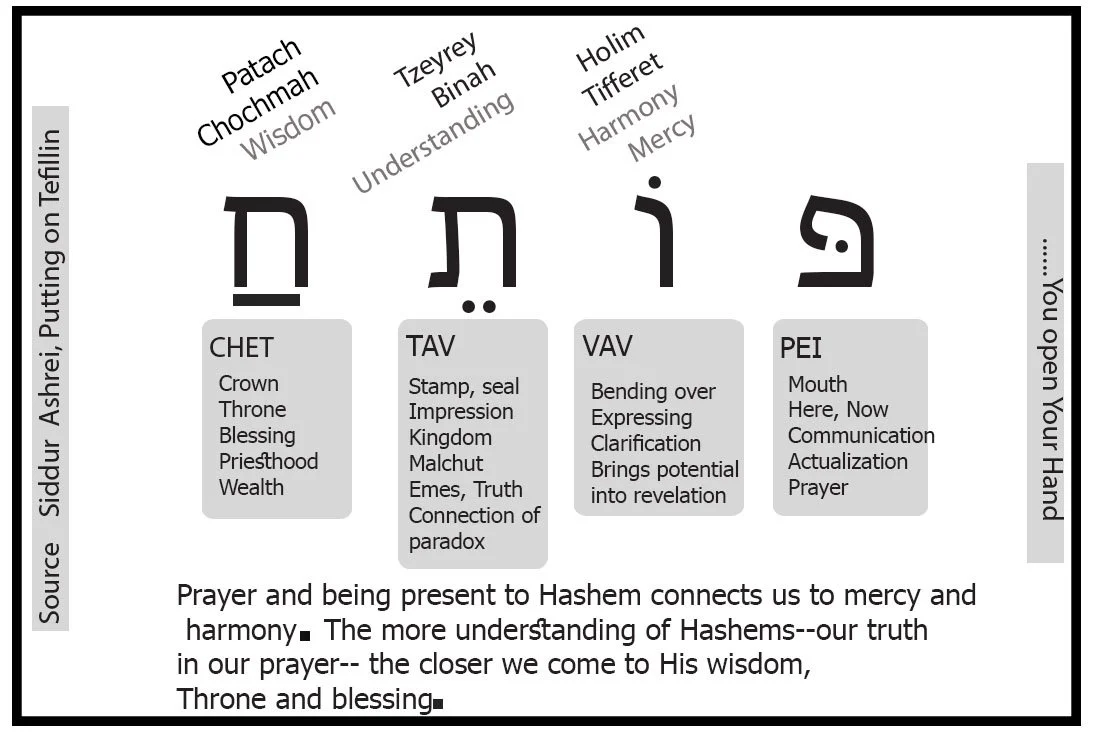The Motion of Holy Words
בס”ד
Keeping Focus
The Baal Shem Tov wrote a letter to his brother-in-law to give him strength and encouragement not to give up (Keter Shem Tov)[1].
The Baal Shem Tov brings to us 3 segulot/fixings (many tzaddikim tell us that the 3 main things that bring much strength to the Jewish people are Torah, Tehillim, and Tanya). Even within every “letter and letter,” there are within it, three things— all intertwined together: Olamot (world/creation), Neshamot /holy sparks (and even that which is within us), and Elokut/divinity.
It is known that neshamot glues the world and divinity together and, on a local level, our holy spark within us, our nefesh,(consisting of thought, speech, and action) is the “inbetweener”,[2] that helps to bring the Upper world and our Lower world together.
It is our work within creation to have our neshamot connect the two.
Each word we daven, says the Besht, also has these characteristics. By holding onto our thoughts (perceptions) about these words and sounds, a unification is formed with Divinity.
We may not get even close to the unifications with which the Besht was experiencing, but by meditating a few moments upon what exactly is coming from our thought, speech, and action, we also perform a unification— a turning over of physical connecting it to spiritual Gdliness.
This is for us to do in our world and we must hold onto this focus.
[1] https://www.youtube.com/watch?v=ugJeIukCdSI. director@ascentofsafed.com.
[2] Rabbi Moshe Miller, The Practical Tanya (Brooklyn, NY 2017). chaimmiller@gmail.com.
Words and Vowels
Hebrew, the Holy tongue of Torah scriptures, is endowed with strength and Gdly energy. Our words flow from our mouth enunciating words utilizing a combination of air (breath), water (moisture from the windpipe), and fire (heat from the heart and body). Scholars and kabbalists tell us that the vowel signs are like the soul to the body, the letters. Words made up of only letters cannot be uttered. They are letters without a soul.
Hebrew letters are accompanied by vowel notations, e.g., “nikudot,” These vowel signs help us to pronounce the words as we breathe into them. There are many Chassidic sources that bring to light the connection of the Hebrew vowels with the sefirot.
With Jewish meditation, much depth can be sensed with one word—its definition, each letter’s meaning, and the sefira to which the letter is connected. Placing these aspects into the context of the phrase from the Jewish prayer Siddur brings layers upon layers of meaning.
Here are some examples which can help to focus on various words within their context.
The Flow of Abundance
מדשן is defined as "Abundance" as seen in "They shall be sated from the abundance of your house."
בס”ד
The scholars and kabbalists tell us that the vowel signs are like the soul to the body, the letters.
Words made up of only letters cannot be uttered. They are letters without a soul.
The Tzemak Tzedek reminds us that the vowels are t’shuvah—the vowels will return the letters back to their correct and holy state.
WATCH: “The Soul of the Letters”,
Rabbi Aaron L. Raskin
t is well known and widespread among all the scholars of Yisrael, that all the nikudot and vowels were received from from Ezra the scribe, who received it from many antecedents who had passed the information mouth to mouth, clear back until from Moshe on Mt Sinai who received it from Gd. The vowels were formally introduced to the Jewish people by Ezra even though they were well known and utilized prior.
Ramak, Moses ben Jacob Cordovero, Safed
Poteach: Being present to Hashem
Baruch: The Flow of Blessings
ברוך is defined as "blessed" and demonstrates the flow from Hashem above to down below.
Favorite sources for further learning about vowels and sefirot are:
“The Hebrew Letters,” by Rabbi Yitzchak Ginsburgh
“Understanding the Alef-Beis,” by Dovid Leitner
“Sefirot HaOmer,” compiled by Rabbi Daniel Stavsky
“Letters of Fire,” by Rabbi Matityahu Glazerson
“The Practical Tanya,” compiled by Rabbi Chaim Miller
“Sefer Yetzirah; The Book of Creation,” compiled with commentary by Aryeh Kaplan
A Torah Gemstone from Daniela Partouche describing the Hebrew words for “weapon” and “kiss.”




